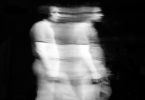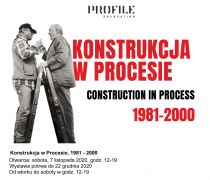Ryszard Wasko with the group of Polish artists from Lodž Museum Artistow finaly didnt arrived. Adam Klimczak told, that customs officers on the Czech Polish border searched the baggage and estimated, that the VHS cassettes in Wasko´s bag měl must be contraband. Wasko was not transparent messenger, but smugger. We dont know it Klimczak didnt make it up, and we dont know what Wasko planned to screen. We can presume, it could be documentation from "Construction in Process", or his film experiments from early 70ies. in 2017 the Internet makes possible to include here his digital films from Vimeo. After 23 years we can repair the absence of Ryszard Wasko in Plasy.
V první polovině 70. let byl Waško člen kolektivu Warsztat Formy Filmowej [Film Form Studio], která vznikla na Lodžské filmové akademií (Łódzka Szkoła Filmowa / Film School in Łódź). Jeho kolegové byli filmaři jako Paweł Kwiek, Józef Robakowski, nebo Zbigniew Rybczyński. Waško se tehdy soustředil na konceptuální analýzu filmového media, vedle filmu se zabýval také videem, fotografií, instalacemi, kresbou a zkoumal způsoby jak pomocí těchto prostředků zachytit vztahy mezi časem, prostorem, pohybem a modus vnímání. Tyto elementy analyticky obnažoval a snažil se dekonstruovat základní principy media pohyblivého obrazu a fotografie.
Waško používal kameru nejen jako prostředek k dokumentaci, ale také jako nástroj performance. Například ve filmu "Od A do B a zpět k A" (From A to B and back to A, 1974) analyzuje vztah mezi prostorem, zvukem (mikrofonem) a obrazem (kamerou). Fotografická série "Od 0° do 180°" (From 0° to 180°, 1971) propojuje obrazové percepční pole člověka s optickým rámcem objektivu kamery: sledujeme pohyb hlavy nahoru a dolů a na stranu. Instalace Roh/Corner z roku 1976 sestávala z monitoru umístěného v rohu místnosti, na kterém byl živě obraz z kamery, namířené do roku v jiné, vedlejší místnosti.
Ryszard Wasko (born 1947 in Poland) is one of the leading contemporary conceptual artists, employing photography, film, video, installations, painting, and drawing in his practice. He organized Construction in Process (1981-2000), and the Łódź Biennale (2004-2010). He lives and works in Berlin, and is represented by the Zak Branicka Gallery. Waśko was a member of the Workshop of the Film Form (1970-1977) but later returned to painting and developed conceptual art. In the 1970s, he participated in XII Sao Paulo Biennale, documenta 6, 3. Festival of the Film Avant-Garde in London, Sydney Biennale, and XI Paris Biennale. Represented by m gallery in Bochum, in 1980 he was the only artist from behind the Iron Curtain to participate in Pier and Ocean (Art of the70s) at the Hayward Gallery in London. In 1981, he organized Construction in Process in Łódź, the first international exhibition of contemporary art in Poland organized independently. Since 1983, he lived in Germany. In 1990-1992 Wasko was artistic director of P.S.1 in New York, and from 1993-2008 he lived in Poland where he organized the Łódź Biennale. He participated in group exhibitions in Centre Pompidou in Paris, Hamburg Kunsthalle, and Venice Biennale (1991, 1999, 2001, 2007); his experimental films were presented by Tate Modern in London and MoMA in New York. Waśko taught at St. Martin’s School of Art in Wimbledon, Hochschule der Künst in Berlin, Freie Kunstakademie in Essen, and other important schools.
Ryszard Wasko's works belong to the collections of such museums and institutions as: Lenbachhaus Museum in Munich, Łódź Art Museum, Berlinische Galerie and Neuer Berliner Kunstverein in Berlin, Centre Pompidou in Paris, Arts Council in London, Haifa Museum of Art, Wilhelm-Hack Museum in Ludwigshafen, Art Collection of the World Bank in Washington, D.C., and Regional Museum in Bydgoszcz.



